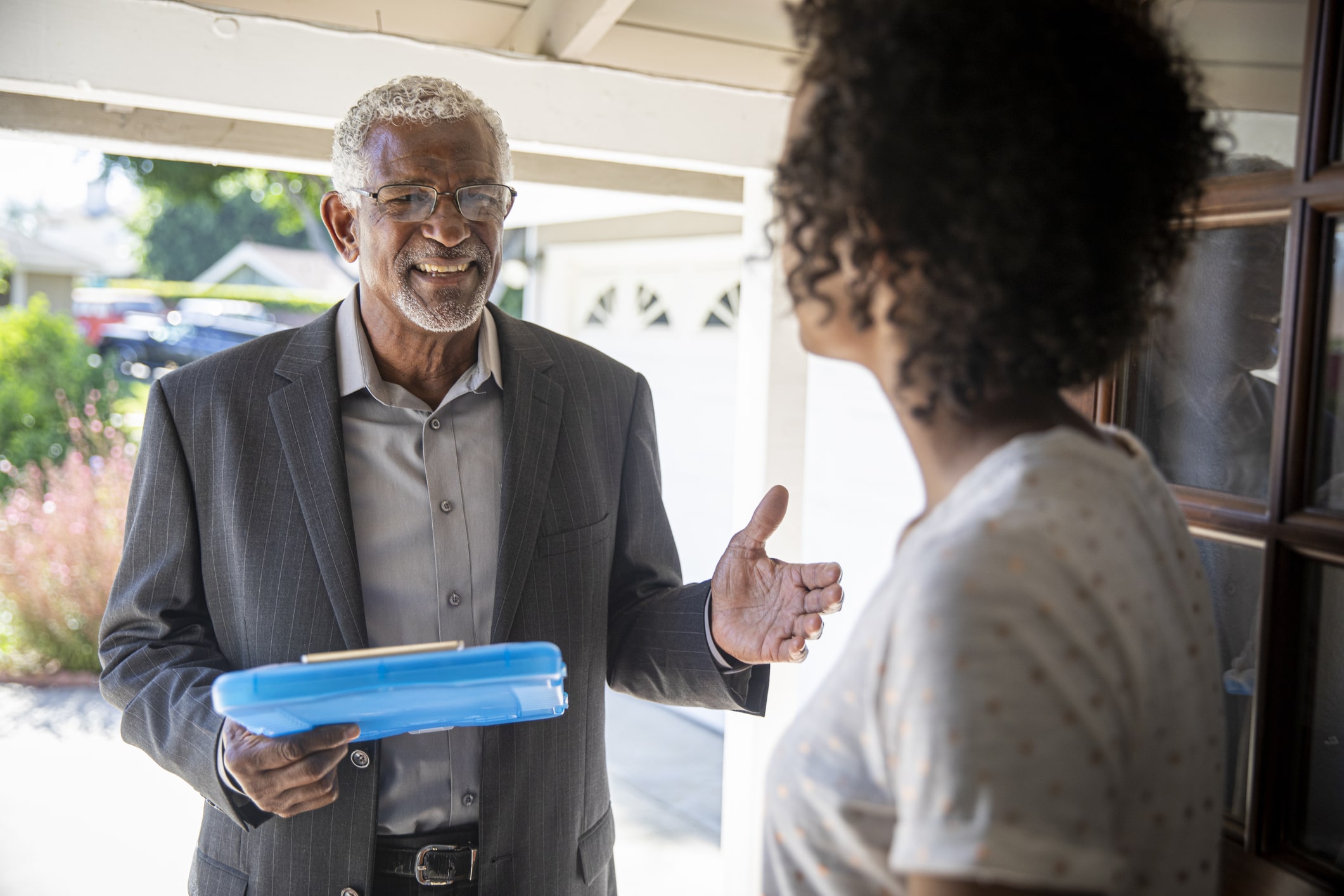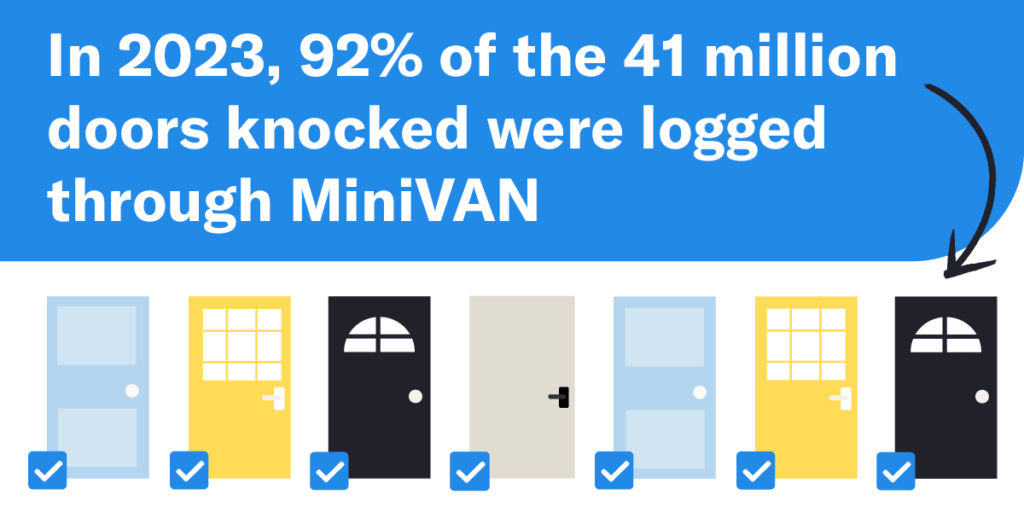Canvassing do’s and don’ts that every canvasser should know

Speaking with voters face-to-face is one of the best ways to educate, persuade, and mobilize them to vote for a candidate or cause, making door-to-door canvassing an essential part of any political campaign. But it can be intimidating to talk to strangers on their doorsteps, especially in an emotionally charged political climate.
That’s why canvassers should brush up on best practices before they start knocking doors — so they can feel empowered, safe, and prepared to represent their candidate well.
Whether you’re an experienced campaign manager or a first-time canvassing volunteer, knowing these canvassing do’s and don’ts will help you reach more voters while keeping every volunteer energized and safe.
FAQs about canvassing do’s and don’ts
Before we get into the weeds of our canvassing do’s and don’ts, we’ll answer a few common questions you might have about how to canvass.
What do you say when canvassing?
What you say when canvassing will vary depending on your candidate, campaign strategy, or cause’s, along with how close you are to Election Day. However, you’ll typically follow this general structure:
- Introduce yourself and the organization you’re working with.
- Provide basic information about the campaign, such as the candidate’s background, policy positions, and platform.
- Ask about the voter’s opinions and if you can count on their support.
- Thank the voter for talking to you.
No matter what, individual canvassers should follow the scripts that the campaign provides them. Campaign organizers develop canvassing scripts based on a specific strategy, and veering off script could jeopardize that strategy or be inconsistent with current campaign messaging.
What should you wear when canvassing?
Every canvasser should dress comfortably but maintain a clean, professional appearance. Wear clothes and shoes you can easily walk in for several hours. For those who might be physically challenged, the campaign can provide you with a phone list so you can call voters instead of walking and knocking.
As an organizer, you might ask volunteers to wear specific campaign-branded items, such as a t-shirt, button, or hat for easier identification. This will ensure voters can quickly identify your campaign and canvassers can find each other if they have questions. Plus, establishing a “uniform” for canvassing will give your volunteers clear direction for how to dress, which may put them more at ease if they’re new to canvassing.
How do you canvas effectively?
An effective canvas is one that brings valuable information back to the campaign and achieves the campaign’s goal for that canvas. Most canvasses are meant to be for voter identification, but others are for finding volunteers, notifying about events, or mobilizing supporters.
Make sure you understand the goals of the canvass you’re participating in before going out on the streets so you know how to canvass effectively. Then, follow our general canvassing do’s and don’ts to have the best chances of reaching the campaign’s goals.
10 political canvassing do’s
Here are 10 things that campaign organizers and individual volunteers should do while canvassing.
1. Train your volunteers.
Not every volunteer will be experienced, and brand-new volunteers and those who sign up for canvassing at the last minute are still valuable additions to your campaign team. They just need some basic training on what to do and how to represent your campaign well.
At the beginning of each canvass, field staff should take time to train volunteers to:
- Use relevant canvassing software or apps.
- Follow the campaign’s canvassing script and convey its message accurately.
- Respond to different questions and comments about the candidate.
- Stay safe while canvassing and follow all relevant laws and regulations.
Some volunteers will arrive with more knowledge than others and be ready to start canvassing right away. If needed, you might spend extra time training new volunteers after sending the rest of your canvassers off to begin.
2. Write thorough, branched scripts.
Having a detailed script is essential to successful canvassing. Your script should go beyond basic topics, giving volunteers specific words and phrases to use when discussing the campaign.
Write scripts that address different audiences and directions that the conversation could go. By creating a branched script that provides tailored responses to voters’ answers (both positive and negative), you’ll help your volunteers navigate different conversations and answer common questions.
3. Take notes on voters’ responses.
Whether you’re participating in deep canvassing or just trying to introduce your candidate to voters, you always want to collect information about their responses. As volunteers discuss the campaign with each voter, they should note the voter’s opinions, priorities, concerns, and overall likelihood of support. If your campaign uses a canvassing app like MiniVAN, volunteers can easily leave notes about each conversation within the app.
4. Use MiniVAN.
NGP VAN’s MiniVAN canvassing app is the top canvassing tool used by Democratic and progressive political campaigns, with 92% of doors knocked in 2023 being logged in the app.

MiniVAN simplifies canvassing for both field organizers and volunteers by keeping all the information they need in one accessible app. Using MiniVAN makes canvassing more efficient and successful by enabling volunteers to:
- Easily access canvassing scripts.
- See maps of their assigned turfs and lists of target voters.
- View information about voter demographics, party registrations, and polling locations.
- Record which voters they were and were not able to speak with.
- Enter and view notes after each conversation.
- See their progress throughout the canvass, along with their partner’s progress.
- Knock on doors with confidence.
Additionally, the data volunteers enter automatically syncs with your voter database to reduce time spent on manual data entry.
If you’re running a larger campaign, you can also consider using MiniVAN Manager. This tool comes with add-on features for organizers that help them see canvassers’ real-time locations, monitor their contact rates, and identify top volunteers.
5. Carry identification.
Whether you ask volunteers to wear campaign t-shirts or provide them with cards that clearly state they work for your campaign, all volunteers must identify themselves clearly as canvassers. As soon as someone answers the door, you should introduce yourself and say right away that you’re canvassing for your candidate’s campaign.
6. Target the right voters.
Reaching your canvassing goals is only possible if you target the right voters in the first place. Refer back to the potential canvassing goals we discussed earlier and clarify whether you should target your mobilization or persuasion universe (or if you’re just collecting information and don’t yet know who should make up each universe).
For example, if your campaign’s goal for a canvass is to encourage likely supporters to cast their votes, you would target your mobilization universe. This means you should use your voter database to create canvassing lists made up of voters who you’ve identified as supporters or are likely to support your candidate.
7. Prepare for different responses.
This is where branched scripts come in handy — they help volunteers know how to respond to a variety of different opinions that voters express. Specifically, it’s helpful for organizers to prepare responses that volunteers can give when voters are:
- Strong supporters
- Likely supporters
- Undecided voters
- Likely opponents
- Strong opponents
Ideally, your canvassing script will have responses you can give in each situation. For instance, you might thank a possible supporter and suggest they visit your candidate’s website. For a potential opponent, you might provide more information about your candidate’s stance on a particular issue that many opponents care about. Some campaigns assign number values to their supporters. For instance, strong support is usually designated by the number 1 and strong support of an opponent would be a number 5. A campaign manager might say “give me a list of all the 1’s in the district.”
8. Knock on every door on your list.
Campaign organizers typically assign each pair of volunteers to one “turf,” which is a list of target voters who live in a specific area. Canvassers then use a map or canvassing app to knock on each door, and they can request another turf if they get through their initial list early.
As a volunteer, make sure to knock on every door on your list, even if it looks like the voter isn’t home. If they’re not available, leaving campaign literature and recording that information can still ultimately help your campaign get closer to its vote goal.
9. Follow all local laws.
Refer to your relevant election authority to ensure you and your volunteer canvassers follow all the canvassing and election laws that apply to your race. This often includes respecting “No Trespassing” signs and carrying identification. Local laws may also dictate specific times you can canvass, such as only between 9 a.m. and 9 p.m.
10. Stay safe while canvassing.
Since canvassing involves interacting with strangers, navigating unfamiliar neighborhoods, and being outside for extended periods, it’s important to keep safety in mind at all times. If you’re an organizer, make sure to give your volunteers safety tips like:
- When possible, canvass in pairs.
- Do not canvass after dark.
- Keep a charged phone on you at all times, or bring a power bank.
- Never go inside a voter’s home, even if they invite you.
- Always carry water and a snack, since your shift might last a few hours.
- Stay hydrated and seek shade if temperatures are high.
- Be prepared for different weather situations.
If you or another volunteer ever feels like you are in danger while canvassing, do not try to get a hold of the campaign staff or shift leader. Call 911 and get to safety as quickly as possible.
11 canvassing don’ts
Now that you know what to do when canvassing, learn what not to do by exploring these crucial canvassing don’ts.
1. Don’t go off script.
As mentioned earlier, canvassing scripts are strategically created to align with a candidate’s campaign plan and message, so it’s important to stick to what’s written. Don’t go off-topic, and don’t embellish or add anything that may not be true. Before you canvass, try to practice reading the script and responding to potential objections while staying on topic. This will help you get more comfortable with the script and sound confident when you talk to voters.
2. Don’t put campaign literature in mailboxes.
This doesn’t mean you shouldn’t give out campaign literature when canvassing — you should. Campaign literature like pamphlets or flyers helps you share information about your candidate with voters who aren’t home. These pamphlets may include the candidate’s background, platform, and social media pages, along with key voting information like registration deadlines and early voting dates.
You just can’t leave literature inside mailboxes because it’s against federal law. You can leave campaign literature on voters’ doorsteps or hanging on door handles, or just on their front porches. Each time a canvasser leaves literature with a voter, they can also mark it in the MiniVAN app so you don’t deliver the same information twice.
3. Don’t ignore “No Trespassing” signs.
In most states, there are few restrictions on where political canvassers cannot enter, since canvassing is not considered soliciting. However, there is one notable exception — it’s illegal to canvass on a property with a “No Trespassing” sign. For example, Tennessee law states that “Canvassers may enter private property as long as ‘No Trespassing’ signs are not visible.”
To remain compliant with your local laws and avoid entering potentially dangerous situations, do not ever ignore a “No Trespassing” sign. Mark down that you couldn’t contact the voter due to a sign, and move on with your list.
4. Don’t canvass during off hours.
Whether or not your district has regulations about the times of day you can and cannot canvass (refer to your relevant election authority if you’re not sure), certain times are typically considered off-limits. To respect voters’ time and privacy, you shouldn’t canvass:
- Too early in the morning.
- Too late in the evening.
- During common meal times.
The best times to canvass tend to be weekend mornings and early evenings (before sunset) on weekdays.
5. Don’t be rude or aggressive.
All volunteers want to represent the campaign well and form a positive impression on voters, so avoid using any rude language or getting visibly irritated at the voters you talk to. Even if a voter is rude to you, don’t engage, as this could reflect badly on the campaign as a whole. Instead, thank the voter for their time and leave the conversation.
6. Don’t disrespect voters’ privacy.
Be considerate of every voter’s privacy and conscious of the fact that you’re entering their personal space. This means you should not:
- Enter any voter’s house (even if they invite you).
- Stay when someone asks you to leave.
- Invade personal space by standing too close to them or touching them.
- Walk on voters’ lawns.
- Pet their dog or cat without asking.
- Pry into personal matters during a conversation.
- Disrespect or damage anyone’s property.
Additionally, be careful not to assume relationships between people (such as assuming two people are married). This could come off as disrespectful and hurt your chances of winning that voter’s support.
7. Don’t forget to say thank you.
Even if a voter says they’re not interested in supporting your candidate or having a full conversation with you, thank them for their time. Ending every conversation with a thank you ensures that volunteers stay respectful and leave voters on a positive note.
8. Don’t continue a conversation that’s going nowhere.
If it’s clear that a conversation is going in circles or that you won’t convince an unlikely supporter to vote for your candidate, know when it’s time to end the conversation. Every volunteer has a limited amount of time and a long list of doors to knock on, so don’t waste too much time on unproductive conversations. Thank them for their time and wish them a good day/evening, note the details of the conversation in MiniVAN, and move on to the next door.
9. Don’t canvass alone.
For safety reasons, it’s best to canvass in pairs or groups when possible. You should always be within sight of another volunteer and able to contact them in case of an emergency.
To facilitate this, field organizers should clearly divide volunteers into assigned pairs or groups at the start of any canvass. If a canvasser does go out alone for any reason, campaigns with MiniVAN Manager can use the app to track their locations and monitor their contact rates.
10. Don’t respond to disrespectful comments.
While you should correct any false statements about your candidate and respond to negative comments about the campaign, don’t engage with any personal attacks. If a voter is aggressive or makes a racist, sexist, or otherwise derogatory comment about you, leave the conversation right away.
Volunteers’ safety is the number one priority, and you don’t want to risk these situations getting out of hand.
11. Don’t get into arguments with voters.
On a similar note, don’t get into arguments with people — chances are, you will not change their minds. If a voter wants to argue with you, you should instead:
- Provide them with campaign material.
- Stick to the script, following any responses provided for voters who express opposition.
- End the conversation and move on to the next house.
Remember to always stay as safe as possible. If you think you may be in danger, call 911 and get to safety right away.
Bonus canvassing tips for organizers
Planning and executing a successful canvass takes work. For field organizers, following these bonus tips can help you make your canvassing activities as effective as possible:
- Debrief with volunteers after they canvass. Spend some time talking to your canvassers at the end of the day to discuss how everything went. Ask them if they ran into any problems, had a particularly good conversation, etc. This will help you engage volunteers and keep them motivated to canvass again.
- Take note of your best volunteers. Every volunteer has a different skill set, so some will naturally be more effective canvassers than others. Pay attention to the volunteers who seem particularly deft at navigating difficult conversations and convincing voters to support the campaign — they may be good contenders for leadership opportunities.
- Collect feedback from volunteers. During your debriefings, open the floor for volunteers to provide feedback on what could be improved going forward. For instance, they might let you know that their turf was too spread out or that they would’ve found it helpful to have a more detailed script.
All of this insight can help you improve the volunteer experience and your overall canvassing strategy. Don’t be afraid to adjust your script or canvassing approach based on what’s working well and what isn’t.
Following our canvassing do’s and don’ts
Keep each of these canvassing do’s and don’ts in mind as you knock on doors or plan your campaign’s strategy. Remember to listen to voters, be considerate, and lean on software like MiniVAN to make canvassing easier for everyone.
To learn more about how MiniVAN can improve your campaign’s canvassing, schedule a demo and meet with our team of experts.



